Lair of the Lich

Photo of gameboard for prototype testing.
Lair of the Lich was a design project in making a physical game as a paper prototype. Players took the role of a Lich fighting for supremacy, using spells represented on cards for the purpose of randomization. Each player assumed the role of a Lich vying for supremacy, using cards to cast spells, summon monsters, and manipulate the battlefield. Victory was achieved by eliminating rival players and strategically managing limited resources. The project aimed to balance randomness, skill, and creative problem-solving, encouraging players to experiment with spell combinations and adaptive tactics. Playtested at Cal State University East Bay, players will be referred to as 'A', 'B', 'C, and 'D' in these results.
I was responsible for developing the game’s core rules, designing and producing prototype components while managing physical sessions. I also analyzed player behavior during testing sessions and used those insights to refine both clarity and pacing for future iterations of the design. During my initial playtest, some of these behaviors noticed included: Player A adopted an aggressive hit-and-run approach, expending high-power options early but managing to survive ten rounds. Player B used traps strategically to control space but occasionally misallocated their other skills. Player C was eliminated early due to aimless movement, while Player D capitalized on pushing mechanics for instant kills on enemies around 'bottomless pits'.

Playtesting cards representing various enemies to the player, along with their 'token' on map.
These sessions revealed that the strongest moments of enjoyment came from players discovering clever synergies between mechanics. Conversely, players who lacked early direction felt less engaged, highlighting the need for clearer guidance on playstyles at the start of the game. Based on this feedback, I identified several areas for improvement: better color coding and visual clarity for game components, rebalancing trap costs to encourage use, and revising room selection to prevent early-game decision fatigue. My proposed solution involved providing each player with a balanced starter layout that could be customized after several rounds, helping newcomers understand strategic depth before being overwhelmed with options.
Through this process, Lair of the Lich evolved into a more refined and readable prototype that demonstrated how iterative testing and thoughtful feedback analysis can transform an experimental paper concept into a cohesive and engaging tabletop experience. In reflection on the project now, I enjoy the unique experience of putting players into very difficult questions of how they expend their gold for advantage in a brutally fast game. On the other hand, movement often felt slow even in later iterations, with the gamemap often keeping players apart for "too long", losing half their health to generic npc enemies on average.